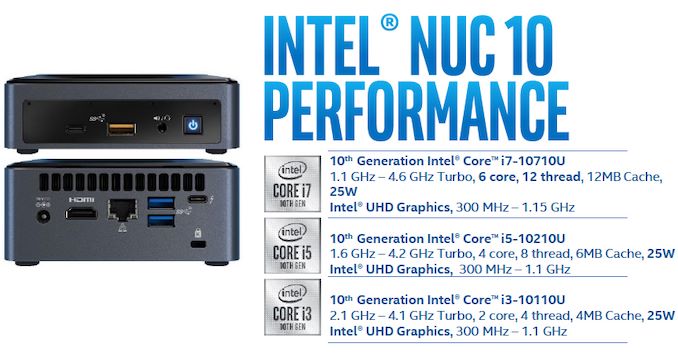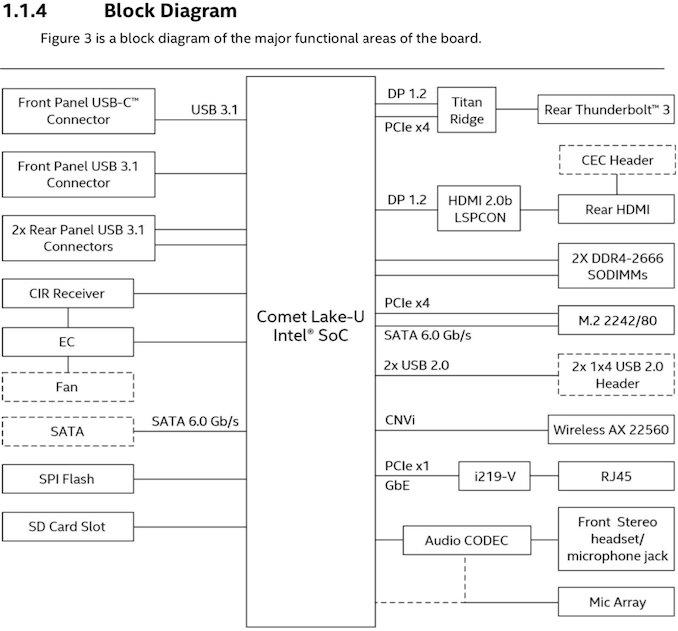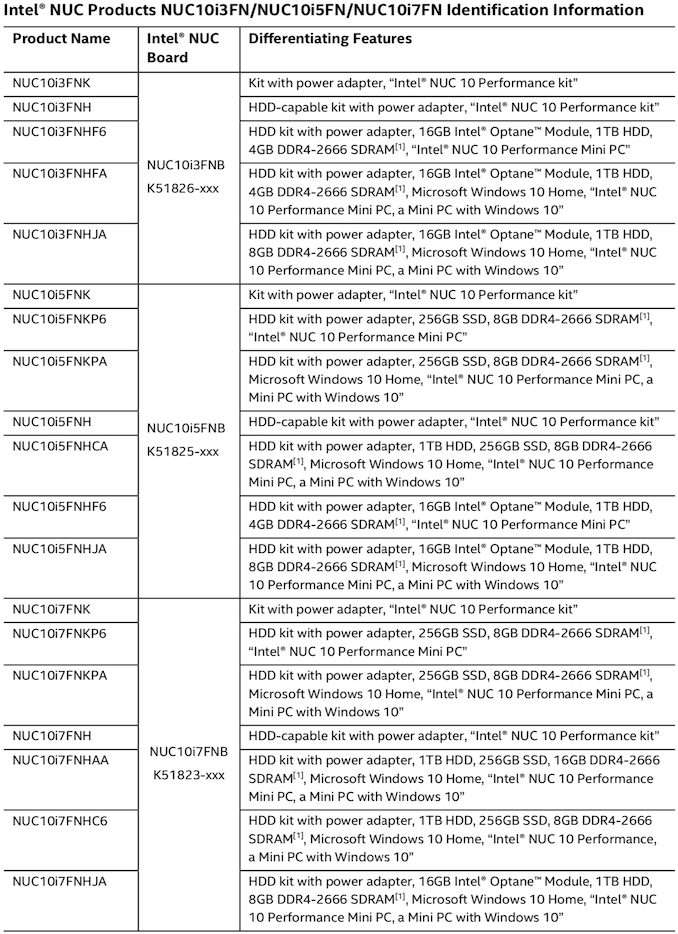Intel Confirms Comet Lake-Based NUC 10 ‘Frost Canyon’ UCFF PCs
by Anton Shilov on November 21, 2019 8:00 AM EST- Posted in
- Desktop
- Intel
- NUC
- UCFF
- Comet Lake
- Frost Canyon

Intel has officially confirmed plans to release its NUC10 ‘Frost Canyon’ ultra-compact form-factor PCs with mobile Comet Lake processors. The main selling point of the systems will be CPUs with up to six x86 cores as well as support for up to 64 GB of DDR4 memory, offering the laptop platform in a pint-sized desktop form factor.
Intel’s NUC 10 ‘Frost Canyon’ lineup is based on Intel’s 10th Generation Core i3-10110U/i5-10210U/i7-10710U processors with two, four, or six cores, as well as UHD Graphics. The NUC family will include three base versions: the slim NUC10FNK with an M.2 slot for SSDs, the taller NUC10FNH with a 2.5-inch bay and an M.2 slot, as well as the NUC10FNB motherboard enabling third parties to build clones of the Frost Canyon in different chassis. In total, Intel will offer over 20 different NUC 10 SKUs (PCs, kits, boards), offering different specifications, level of performance and pricing. All systems will use CPUs featuring a configurable TDP-up of 25 W and therefore the processors will work at higher Turbo clocks all the time granted that they will be cooled using an active cooling system.
The Intel NUC 10 platform will have a Thunderbolt 3 port controlled by Intel’s Titan Ridge chip, USB 3.2 Gen 2 and USB 2.0 Type-A ports, GbE, HDMI, and the usual audio connectors. As an added bonus, the Frost Canyon NUC PCs are also equipped with far-field microphones supporting Amazon’s Alexa and Microsoft’s Cortana assistants.
With rather powerful processors and sophisticated connectivity, Intel’s Frost Canyon UCFF PCs look very potent for various applications except gaming as Intel’s UHD Graphics can barely satisfy those who play demanding titles. Good news is that the systems feature a Thunderbolt 3 port that can be used to connect an external graphics box, but the latter tend to be rather expensive.
Intel’s NUC 10 will be available in the coming weeks. Prices have not yet been published.
Related Reading:
- Intel’s ‘Frost Canyon’ NUC Revealed: SFF PC w/ Comet Lake
- Intel Launches Comet Lake-U and Comet Lake-Y: Up To 6 Cores for Thin & Light Laptops
- Intel Launches Low-End Comet Lake CPUs: Pentium Gold 6405U & Celeron 5205U
- Intel's Bean Canyon (NUC8i7BEH) Coffee Lake NUC Review - Ticking the Right Boxes
- Intel NUC8i7HVK (Hades Canyon) Gaming Performance - A Second Look
- Intel’s Crimson Canyon NUCs with Cannon Lake CPU & Radeon dGPU Available for Pre-Order
- Intel’s Islay Canyon Mini NUCs Available: Whiskey Lake, Radeon 540X, 8GB LPDDR3
Source: Intel (Thanks to SH for the tip)












21 Comments
View All Comments
lakedude - Thursday, November 21, 2019 - link
25 watts from the dual core i3 to the 6 core i7. Looks like some more of those Intel TDP games that only apply to the base frequency. What happens when that i7 hits 4.6 GHz instead of the base 1.1 GHz?Jorgp2 - Thursday, November 21, 2019 - link
Lol, do you people know anythingKorguz - Thursday, November 21, 2019 - link
do you, jorgp2 ???nandnandnand - Thursday, November 21, 2019 - link
We know that Intel lies. Often.edzieba - Thursday, November 21, 2019 - link
"What happens when that i7 hits 4.6 GHz instead of the base 1.1 GHz?"It'll run at 4.6GHz on demand until its combined power/thermal budget runs out, then throttle back. That's how Turbo Boost works. Unless you're running some all-core continuous workload (why are you doing 3D rendering on a NUC anyway?) your workload is going to be bursty rather than steady-state.
imaheadcase - Thursday, November 21, 2019 - link
Have you never heard of Turbo Boost on almost every intel CPU?Smell This - Thursday, November 21, 2019 - link
I would enjoy an AT 'Deep Dive' on the Core i3 to i7 NUCs compared, to the AMD Udoo Bolt / Sequoia embedded UCFF systems, along with a 35w ASRock DeskMini A300-series rig.
. . . with a burger and fries with that?
dullard - Thursday, November 21, 2019 - link
Intel has always stated TDP is for base clocks and turbo is higher power. Why is that a difficult concept?Fulljack - Friday, November 22, 2019 - link
Intel's Turbo specs for i7-10710U is 4.7 GHz for single core or 3.9 GHz for all six core. It's tied into PL4, which takes 90W power and it's Tau (duration) is only 10ms.azfacea - Thursday, November 21, 2019 - link
still no HDMI 2.0 from the iGPU.no one can dispute intel's leadership position as world's no1 laughing stock.